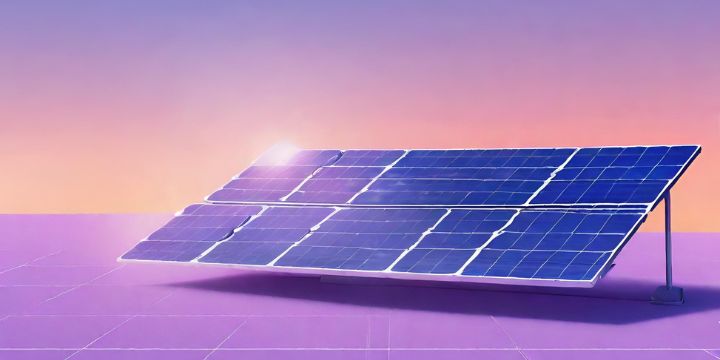What is a Polycrystalline Solar Panel?

A polycrystalline solar panel is comprised of multiple crystals of silicon, a semiconductor material used to convert sunlight into electricity. Polycrystalline panels are made by melting raw silicon and pouring it into a mold to harden, resulting in a block with variously sized crystals.
This manufacturing process is simpler and less expensive than producing single-crystal panels, although somewhat less efficient.
Polycrystalline solar panels typically have lower heat tolerance and conversion efficiency (around 15-20%) compared to single-crystal panels (around 15-23%). However, their lower cost makes them an attractive option for residential and commercial use.
Reliable Power Anywhere
Experience the freedom of portable power with Bluetti's cutting-edge solar generators and power stations. Whether you're camping, preparing for emergencies, or reducing your reliance on the grid, Bluetti offers reliable, eco-friendly solutions that keep you powered up anywhere.
Explore Bluetti Products NowHow Do Polycrystalline Solar Panels Work?
Polycrystalline solar panels convert sunlight into electricity using multiple silicon crystals in each cell.
Polycrystalline solar panels absorb the sun’s energy using photovoltaic (PV) cells made of fused silicon crystal fragments. When sunlight strikes the PV cells, the electrons in the silicon get excited and start moving, creating an electric current known as direct current (DC) power.
An inverter then converts the DC into usable alternating current (AC) power for your home or business.
The multiple crystal fragments in each PV cell allow for some movement of electrons, so polycrystalline solar panels tend to be slightly less efficient than monocrystalline panels, which use a single silicon crystal. However, polycrystalline panels also tend to be more affordable to produce and purchase.
Go Green with Bluetti
Take a step towards sustainability with Bluetti’s advanced solar technology. From high-capacity power banks to efficient solar panels, Bluetti helps you harness the power of the sun to reduce your carbon footprint without compromising on performance.
Shop Sustainable Power SolutionsThey represent a good mid-range solar panel option for most homeowners and small businesses looking to adopt solar energy.
With proper installation and maintenance, high-quality polycrystalline solar panels can last up to 25-30 years. As panel technology continues to improve, newer polycrystalline panels may become even more efficient and cost-effective over time.
Why are polycrystalline solar panels cheaper?
Polycrystalline solar panels are more affordable primarily due to differences in the manufacturing process. Polycrystalline silicon cells are made by melting raw silicon and pouring it into a mold, where it then cools and hardens into an ingot.
This ingot is then cut into wafers to make solar cells. Since the silicon is melted, it has an irregular, unordered atomic structure upon cooling. This less-ordered structure is less efficient at converting sunlight into electricity, but the overall process is faster and less expensive.
In contrast, monocrystalline panels use a more expensive process to form a uniform crystal structure. A seed crystal is slowly drawn from molten silicon, allowing the atoms to align perfectly.
This highly ordered structure is more efficient but more difficult and costly to produce. The additional time, precision, and materials required lead to a higher price point for monocrystalline panels.
The advantages of Polycrystalline Solar Panels
Polycrystalline solar panels offer several benefits over other types of solar panels. Compared to monocrystalline panels, polycrystalline panels tend to cost less per panel, making them a more affordable option for homeowners and businesses interested in switching to solar power.
Despite the lower cost, polycrystalline panels are comparably durable and long-lasting, with a lifespan of at least 25 years.
Power Your Adventures
Don't let power outages or off-grid adventures slow you down! Bluetti's portable solar-powered solutions are designed for convenience and efficiency, making them the perfect companion for any lifestyle.
Discover Bluetti's Portable PowerBy harnessing energy from the sun, polycrystalline solar panels provide an environmentally friendly way to power homes and businesses while reducing electric bills. The solar cells within polycrystalline panels are made of melted and recrystallized silicon, allowing them to convert sunlight into usable electricity for on-site use or export to the grid.
Polycrystalline panels may have slightly lower space efficiency and energy conversion rates than monocrystalline panels, but their higher affordability and similar durability make them an appealing choice for many solar installations.
The disadvantages of Polycrystalline Solar Panels
Polycrystalline solar panels have some disadvantages compared to monocrystalline panels.
Lower efficiency
Polycrystalline solar cells typically have lower efficiency, ranging from 15% to 20% due to lower silicon purity. More impurities in the silicon result in less efficient conversion of sunlight into electricity.
Polycrystalline panels require a larger surface area to produce the same energy as monocrystalline panels.
Higher space requirements
The lower efficiency of polycrystalline solar panels necessitates a higher installation area to generate the same amount of electricity as monocrystalline panels.
More space is needed for the same power output. For residential or commercial installations where space is limited, monocrystalline panels may be preferable.
Poorer performance in low light
Polycrystalline solar panels tend to have poorer performance in low-light conditions compared to monocrystalline panels. Their lower silicon purity and efficiency reduce their ability to make use of the limited available light.
For locations that frequently experience overcast or partly cloudy weather, monocrystalline panels would likely provide better returns.
Disclosure: We may earn commission for purchases that are made by visitors on this site at no additional cost on your end. All information is for educational purposes and is not intended for financial advice. Read our affiliate disclosure.






